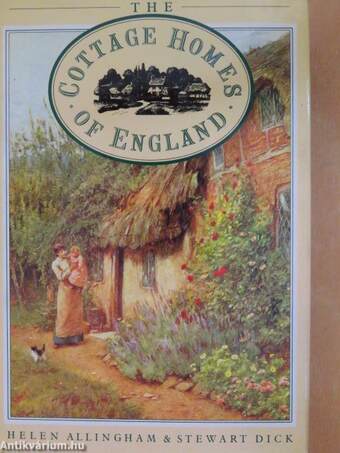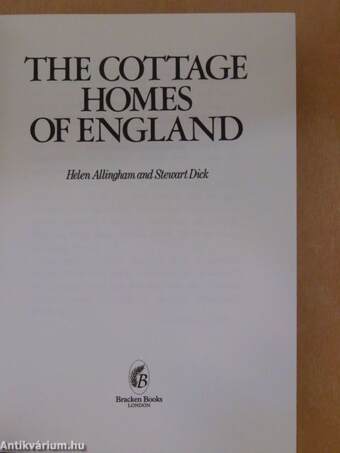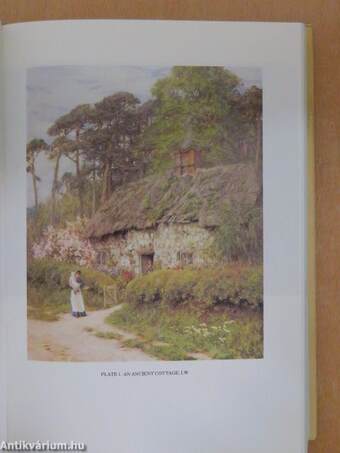1.067.327
kiadvánnyal nyújtjuk Magyarország legnagyobb antikvár könyv-kínálatát

VISSZA
A TETEJÉRE
JAVASLATOKÉszre-
vételek
The Cottage Homes of England
| Kiadó: | Bracken Books |
|---|---|
| Kiadás helye: | London |
| Kiadás éve: | |
| Kötés típusa: | Fűzött keménykötés |
| Oldalszám: | 287 oldal |
| Sorozatcím: | |
| Kötetszám: | |
| Nyelv: | Angol |
| Méret: | 23 cm x 16 cm |
| ISBN: | 0-946495-10-6 |
| Megjegyzés: | Színes reprodukciókkal. |
naponta értesítjük a beérkező friss
kiadványokról
naponta értesítjük a beérkező friss
kiadványokról
Fülszöveg
HELEN ALLINGHAM AND STEWART DICK
Set in unpolluted country, unshaken by motor traffic, Helen Allingham's are the cottages (with plumbing and electricity added) we should all üke to own. She painted them in peaceful Edwardian days, in spring and summer, under cloudless skies. Although at this time she lived in London, she could not keep away from the country and particularly the Surrey she once knew and loved. It is significant that the only touches of autumn that appear in the sixty superb illustrations occur in the single London scene, a picture of Wyldes Farm near her Hampstead home. Chiefly, her subjects come from southern England - Kent, Surrey, Sussex are favourite counties - but she did go as far afield as Alderley Edge in Cheshire, and it is in this picture we see the only blackened timbers in the book. Hers is a green world in which everything grows unchecked: trees dwarf the buildings, creepers reach the chimney tops, herbaceous borders flourish. The cottages sink into... Tovább
Fülszöveg
HELEN ALLINGHAM AND STEWART DICK
Set in unpolluted country, unshaken by motor traffic, Helen Allingham's are the cottages (with plumbing and electricity added) we should all üke to own. She painted them in peaceful Edwardian days, in spring and summer, under cloudless skies. Although at this time she lived in London, she could not keep away from the country and particularly the Surrey she once knew and loved. It is significant that the only touches of autumn that appear in the sixty superb illustrations occur in the single London scene, a picture of Wyldes Farm near her Hampstead home. Chiefly, her subjects come from southern England - Kent, Surrey, Sussex are favourite counties - but she did go as far afield as Alderley Edge in Cheshire, and it is in this picture we see the only blackened timbers in the book. Hers is a green world in which everything grows unchecked: trees dwarf the buildings, creepers reach the chimney tops, herbaceous borders flourish. The cottages sink into the landscape, and sometimes hardly a window shows behind the thick hedges. The artist is never without an excuse for colour: lilac, gorse, bluebells, sunflowers, hollyhocks, faded brick, warn tile, silver stone. Her paint takes on the texture of thatch, plaster, moss, weathered oak, the cob-walls of Devon, and Cotswold limestone.
Stewart Dick's perceptive description of this vanishing world brings to life again the villages and countryside of which the people and their homes were such an organic part. His understanding and insight, combined with secure historical perspective, make this book a celebration of a heritage we should not forget: as he himself says, it is through these homes that the deep main current of English life has flowed.
64 full-colour illustrations Vissza
Témakörök
- Idegennyelv > Idegennyelvű könyvek > Angol > Művészetek > Építészet
- Idegennyelv > Idegennyelvű könyvek > Angol > Művészetek > Festészet
- Idegennyelv > Idegennyelvű könyvek > Angol > Néprajz
- Néprajz > Tárgyi néprajz > Népi építészet
- Művészetek > Festészet > Rajz, grafika > Illusztrációk
- Művészetek > Festészet > Idegen nyelv > Angol
- Művészetek > Építészet > Kontinensek szerint > Európa > Angol
- Művészetek > Építészet > Idegen nyelv > Angol
- Művészetek > Építészet > Épületek > Családi házak > Egyéb
- Művészetek > Építészet > Épületek > Egyéb
Megvásárolható példányok
Nincs megvásárolható példány
A könyv összes megrendelhető példánya elfogyott. Ha kívánja, előjegyezheti a könyvet, és amint a könyv egy újabb példánya elérhető lesz, értesítjük.









